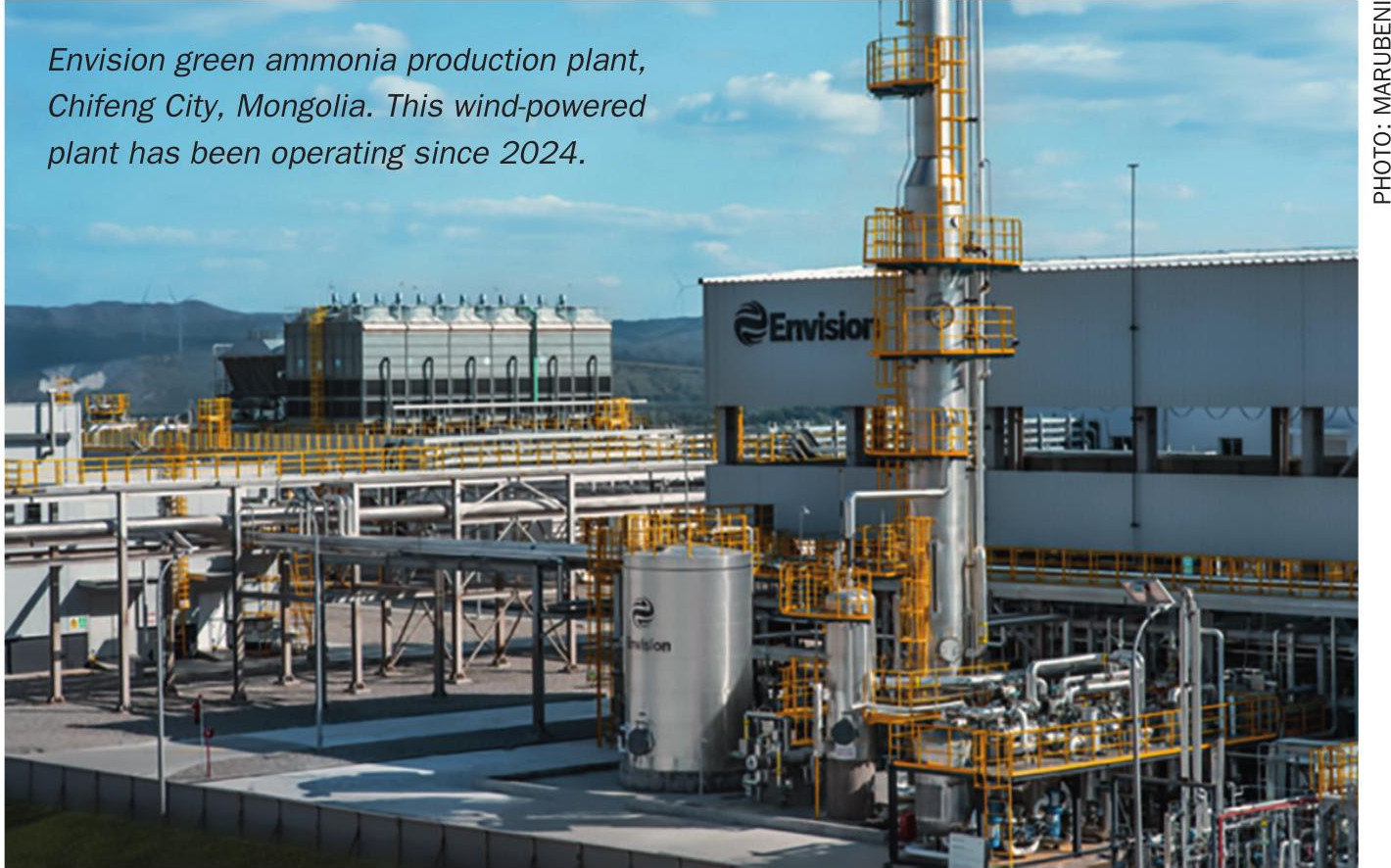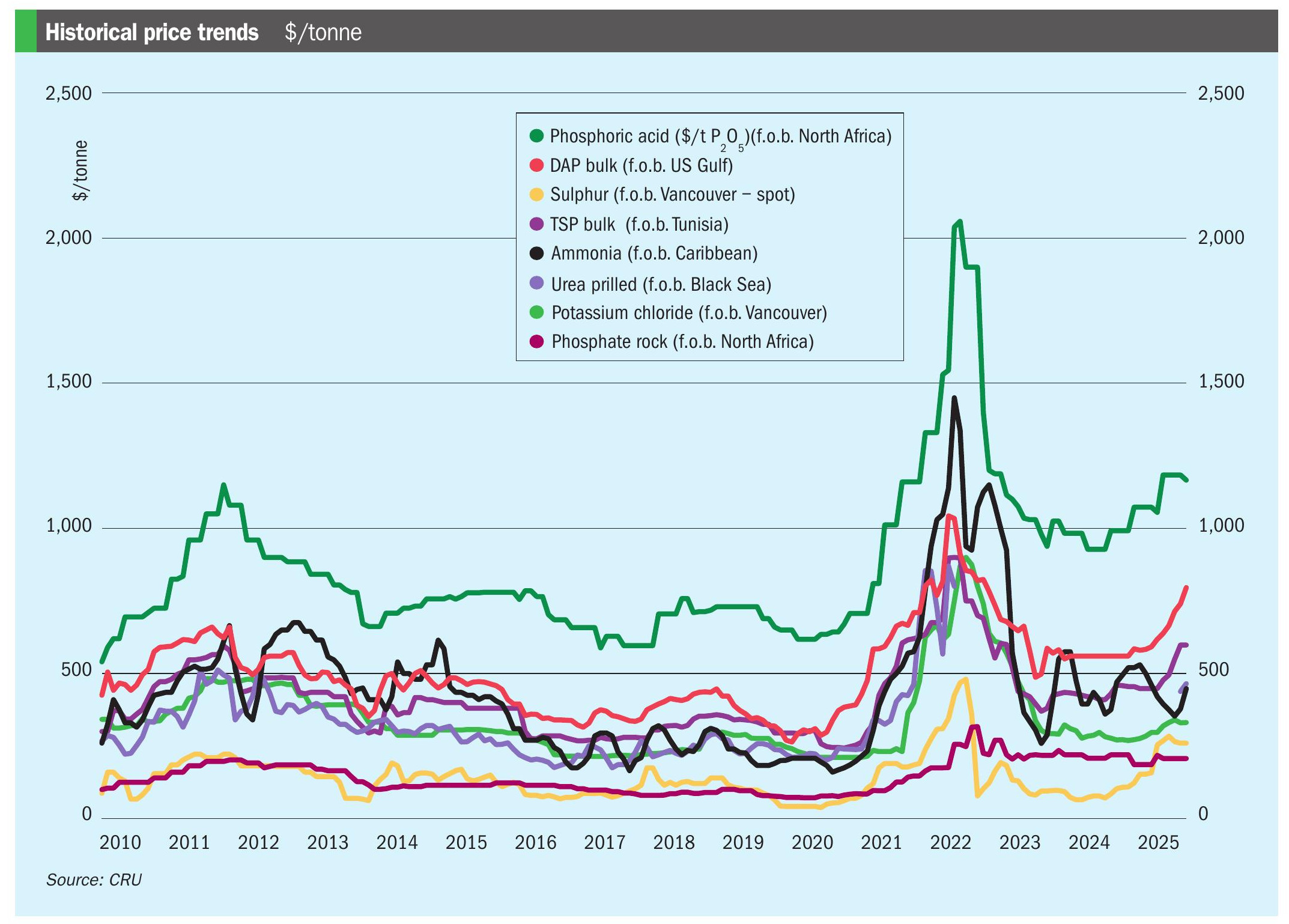Fertilizer International 494 Jan-Feb 2020

31 January 2020
Phosphates project listing 2020
PROJECT LISTING
Phosphates project listing 2020
Fertilizer International presents a round-up of phosphate rock, phosphoric acid and phosphate fertilizer projects.

Phosphate rock projects*

KEY FOR BOTH TABLES
FS Feasibility study complete
n.a. not available
PL Planned
UC Under construction
C Project completed
DAP Diammonium phosphate
DCP Dicalcium phosphate
MAP Monoammonium phosphate
PPA Purified phosphoric acid
SSP Single superphosphate
TSP Triple superphosphate
*Excluding China. Standalone, non-integrated projects only. At present, there are tens of junior phosphate mining projects globally. However, only capacity developments with a published feasibility study are listed here. Additionally, expansions by established producers in Russia (PhosAgro at Kola, EuroChem at Kovdor, Acron at Oleniy Ruchey), and new projects in Kazakhstan (EuroChem), should add more than two million tonnes to regional phosphate rock capacity by 2023. Africa is undoubtedly the region with the most potential for phosphate rock expansion – although large uncertainties over individual projects and their timescales remain. OCP Group is, however, pressing on with ambitious plans to increase phosphate rock capacity at Khouribga and Meskala in Morocco. Avenira was looking to sell its Baobab project in Senegal to a consortium of buyers, as of September 2019. Kropz’s Elandsfontein project should restart this year, if and when its water permitting issues are resolved. The company recently signed a technical cooperation agreement with PhosAgro.
Phosphate fertilizer, phosphoric acid and integrated phosphate rock projects**

**Excluding China. The International Fertilizer Association (IFA) expects various production investments by OCP Group to collectively add an additional 4,350 t/a to Morocco’s finished phosphates capacity out to 2023. Elsewhere in Africa, OCP has also firmed-up joint venture projects in both Nigeria and Ethiopia. The second phosphates mega project announced by Ma’aden and its MWSPC partners should eventually ramp-up product capacity in Saudi Arabia by a further 3,260 t/a. PhosAgro is also expanding phosphate fertilizer and NPK production capacity at its Cherepovets complex by more than one million tonnes, and at the same time enlarging the range of fertilizer grades it produces.
Phosphate technology profiles
Prayon Technologies (PRT)
Prayon Technology (PRT) is the technology arm and subsidiary of parent company Prayon s.a. With experience dating back more than 60 years, PRT considers itself the undisputed global leader in phosphoric acid production technology.
Uniquely, Prayon is both a leading commercial manufacturer of phosphoric acid and its derivatives – purified acid, technical- and food-grade phosphates – and a licensor of phosphoric acid production technology. This provides the Belgium-headquartered company with considerable advantages when it comes to understanding the needs of its technology customers.
A major proportion of phosphoric acid production worldwide relies on Prayon’s process technology. In fact, Prayon Technologies has designed, developed and helped construct more than 135 phosphoric acid plants in more than 30 different countries globally. These plants consume more than 40 different types of phosphate rock and have P2 O5 production capacities ranging from 25 tonnes up to 2,000 tonnes per day.
Prayon offers flexible production technologies able to respond optimally to the requirements of phosphoric acid producers, offering:
- Reduced energy consumption
- increased yield
- Lower production costs
- Excellent environmental performance.
Prayon Technologies essentially offers two types of service: technology licensing and consultancy. Its licensing activities cover:
- Phosphoric acid production – including a full range of processes (DH, HH, DA-HF, CPP, PH2) producing hemihydrate or dihydrate calcium sulphate with one or two filtration step(s)
- Phosphoric acid concentration
- Fluorine recovery
- Gas scrubbing systems – for F, dust and H2 S reduction
- Phosphoric acid purification – SO3 , Cd, As, F, Al2 O3 , Fe2 O3 and MgO reduction technologies
- Phosphogypsum purification
- Uranium recovery from phosphoric acid
- DCP production from low-grade rock and dilute sulphuric acid – the GetmoreP process.
Prayon’s consultancy activities cover:
- Audits of existing plants with specific objectives
- Phosphate rock evaluations
- Plant operator training.
GEA Group
GEA is emerging as a leading technology and equipment provider to the phosphates industry. The Dusseldorf-headquartered group is one of the world’s largest production technology and equipment suppliers and employs about 18,500 people across the globe. GEA generates around 70 percent of its revenues from the food and beverages sector – and is the technology leader in this market.
With more than 100 years of experience in crystallisation alone, the company offers a range of production plant technologies able to meet the diverse requirements of the phosphate and fertilizer industries. They include:
- Evaporators
- Crystallisers
- Membrane filtration units
- Centrifugal decanter and separators
- Spray and fluid bed dryers for drying crystals or granulation.
GEA specialises in the production of water-soluble monoammonium phosphate (MAP) from phosphoric acid. The innovative production technology offered by the company is capable of manufacturing high-quality water-soluble MAP from lower-quality merchant grade acid (MGA). This ground-breaking process reduces opex and/or capex costs as it avoids the need to purchase more expensive purified phosphoric acid (PPA), or integrate a purification line within the fertilizer production plant.
GEA’s process firstly produces a clarified liquid stream after an initial reaction and filtration step. Dry, pure and highly water-soluble MAP crystals are eventually generated as an end-product, after a series of further crystallisation and purification steps. Waste from the various purification and filtration steps, in the form of sludges or purges, still contains some valuable P2 O5 . This can be captured by further processing – for example, via the fertilizer plant’s blending or granulation units.
GEA’s manufacturing process can typically deliver a yield (i.e. the amount P2 O5 recovered to the crystalline end-product vs the P2 O5 contained in the feed acid) of between 50-70 percent. The exact yield depends on the impurity levels in the MGA and the purity/quality requirements (nonsoluble content) of the final MAP product.
GEA’s production technology for water-soluble MAP has already been successfully implemented by an Eastern European customer. The new plant avoided considerable capital and operational expenditure by allowing non-purified MGA to be used as the phosphoric acid feed, while still delivering a pure MAP fertilizer with a high market value as the end-product.

- High-quality water-soluble MAP (typically 12-61-0) with a low insoluble content
- Avoids clogging problems on spray systems and pumps
- Suitable for fertigation, foliar applications and the production of fertilizer blends and nutrient solutions
- Low turbidity after dissolution in water
- High-throughput processing
- Free of chlorine, sodium and other deleterious elements
- Moderate solution pH – safer and less corrosive
- Access to excellent laboratory back-up, support and expertise.






